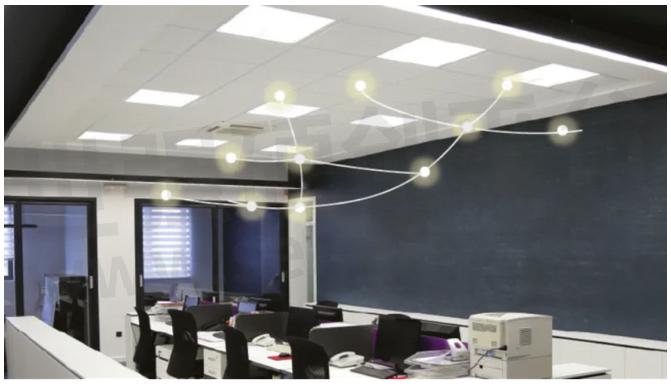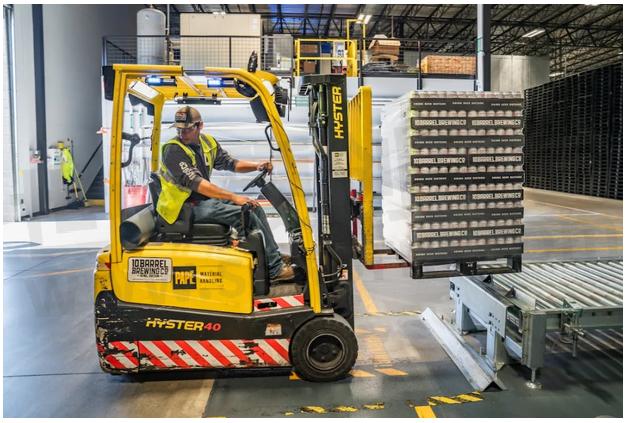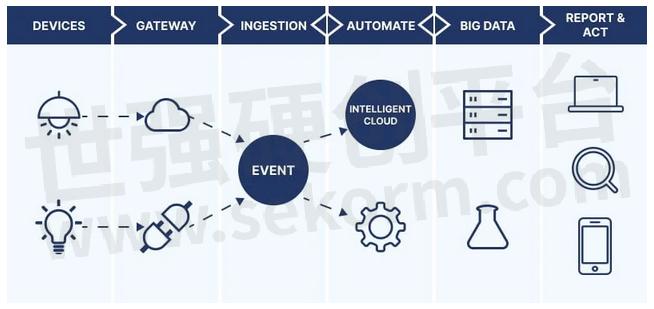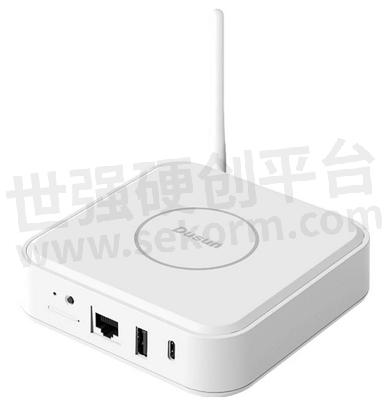How to Using IoT in Smart Lighting (The Most Complete Guide for 2023 from Dusun)




IoT-based smart lighting solutions bring benefits not only to end users but also to businessmen and managers. The global smart lighting market is expected to nearly quadruple to $44 billion by 2030 from about $11 billion in 2020①. With the advent of smart lighting, the latest innovation in lighting, companies and governments are unleashing the power of the Internet of Things to reduce energy consumption and costs.
This article introduces the three categories of smart lighting and the benefits of smart lighting using IoT, especially for related equipment manufacturers and managers.
What is smart lighting using IoT?
Smart lighting employs IoT-enabled sensors, smart bulbs, or IoT gateways to enable users to control their home or workplace lighting through a smartphone or home automation platform. Smart lighting solutions can be controlled by an external device such as a smartphone or smart assistant, scheduled, or triggered by sound or motion. According to their application and control method, the intelligent lighting system in the market is divided into three categories.
Smart bulb

A
smart bulb is an internet-connected LED light bulb that can be
customized, scheduled, and controlled remotely. Smart bulbs are among
the most popular devices in the burgeoning field of home automation and
Internet of Things (IoT) goods.
Smart bulbs may be controlled by a mobile app or an IoT gateway with the integration of Wi-Fi, Bluetooth, ZigBee, or a custom connection for home automation systems, and individual bulbs can be programmed to alter output in a specified manner.
Because the bulb is internet-connected, suppliers may leverage edge computing to outfit smart bulbs with features such as built-in cameras, built-in speakers, and presence-sensing functionality. For the users, you can use phone to turn smart bulbs on and off remotely, adjust the color of their lights, and plan their cycles.
If they link to other smart home gadgets, you’ll be able to design rules that turn on the lights depending on specific events, such as your door opening or a security sensor being activated.
Motion detection smart light

Motion-sensing
smart lights detect and respond to motion by combining sensors,
microprocessors, and wireless communication technologies. Typically, the
sensors are passive infrared (PIR) sensors that detect heat signatures
and movement within their range of vision.
When the PIR sensor detects movement, it sends a signal to the microcontroller, which analyses it and turns on the light. The light may switch on at a pre-set brightness level, or it may gradually ramp up from a lowered level, depending on the smart lighting system.
Some smart lights, in addition to motion detection, may contain other smart sensors, such as ambient light sensors, which detect the amount of natural light in the room and alter the light output appropriately. This improves energy efficiency and eliminates the need for needless illumination.
Smart lighting system connected to an IoT gateway
Commands transmitted from the cloud server will be forwarded to the sub-device network via smart home protocols, built-in apps, and IoT gateways; the status of the sub-device can also be relayed to the server via the IoT gateway. As a result, you can easily operate the IoT smart lighting system from your laptop or mobile phone at any time and from any location.

IoT features for smart lighting
Indoor positioning systems based on lighting: IoT smart lighting may be utilized for indoor positioning, tracking people and assets in real time. The smart lighting system can reliably pinpoint the position of a person or item in a building using sensors and Wi-Fi networks, which may be beneficial for navigation, security, and asset management. IoT smart lighting can assist in minimizing energy use by automatically altering lighting settings and shutting off lights when no one is in the room.
Asset tracking
Smart lighting systems using IoT can be used to track assets, including various equipment in commercial and industrial scenarios, which helps optimize inventory management and reduce the risk of equipment loss.
Perishable product condition monitoring
IoT smart lighting can also be used to monitor the condition of perishable goods such as food and pharmaceuticals. The system can assess temperature, humidity, and other environmental conditions that can affect the quality of items by placing sensors in lighting fixtures. This helps prevent spoilage, reduces waste, and maintains product quality.
Optimize space utilization
Smart lighting systems can also be used to maximize space in buildings such as workplaces and public areas. The technology may alter lighting settings and propose adjustments to the structure of the room to increase efficiency and productivity by studying occupancy patterns and using statistics. This can assist in cutting expenses while also increasing consumer pleasure.

Smart City
Smart cities can’t function without Internet of Things (IoT) smart lighting. By utilizing sensors and automated systems to regulate lighting based on occupancy, time of day, and other criteria, cities are able to save energy and money. Smart lighting also has the added benefit of enhancing security by automatically recognizing and reacting to abnormal occurrences like accidents or crises.
But there’s more to smart cities than just fancy lights. Smart transportation, waste management, public safety, healthcare, and many other interconnected systems and services are all part of it. Together, these solutions will help the city run more efficiently, raise residents’ standard of living, and lessen its environmental impact.
It is frequently situated overhead, which is a practical location to give full coverage, thanks to the smart lighting design. Smart lighting won’t compromise the space’s aesthetics or functioning and won’t necessitate a new architectural design in order to improve the lighting infrastructure of a city, industrial park, or store.
Benefits of smart lighting
The advantages of smart lighting solutions for inhabitants, such as ease and customization, are frequently mentioned. In addition to those end-users, equipment manufacturers and estate managers may reap the benefits of smart lighting technology.
Reduced manufacturing costs
Smart lighting systems can be made more efficient by using fewer materials and components. Smart LED lighting systems, for example, use fewer bulbs and fixtures than traditional lighting systems, lowering the quantity of material needed for manufacture. Furthermore, smart lighting systems may be engineered to utilize less electricity, lowering manufacturing costs and resulting in more energy-efficient goods.
Enhanced product features
Smart lighting may be included in equipment manufacturers’ goods to bring new features and capabilities that help differentiate their products in the market and boost their value proposition. Smart lighting systems, for example, may be built to be controlled by voice commands or mobile apps, providing consumers with a new level of convenience and usefulness.
Increased energy efficiency
Increased energy efficiency is one of the key advantages of smart lighting. Managers can monitor and regulate lighting consumption throughout their facilities using smart lighting, allowing them to optimize energy usage and minimize expenditures. They can, for example, set up automatic schedules that turn off lights when they are not needed or vary the brightness of lights based on the quantity of natural light in the space. The IoT smart lighting system aids in lowering energy use and power costs, which can have a substantial influence on the bottom line.
Decision optimization
Smart lighting solutions may also give important data based on IoT technology about energy usage, lighting patterns, and occupancy levels, allowing managers to make educated facility management and maintenance choices. People can use data gathered from the IoT gateway to detect underutilized or overutilized regions of their facilities and alter lighting accordingly. This can aid in optimizing facility utilization and lowering expenditures.
How does the IoT gateway work with smart Lighting?
When utilized with smart lighting, an IoT gateway acts as a hub to connect and manage the smart lighting devices. This is how it goes:
Communication protocols
The smart lighting devices and IoT gateway must be able to communicate with one another. Typically, a wireless technology like Zigbee, Z-Wave, or Bluetooth is used for this.
Data transmission
The IoT gateway will receive data from the smart lighting devices, including the device’s current state (on/off), brightness level, and any other information it can handle. The communication protocol is used to send this data.
Processing at the gateway
Following receipt of data from the smart lighting devices, the IoT gateway processes that data. This could be keeping the data for later use, looking through it to find trends, or acting on the information received.
Control and automation
Control and automation of the lighting devices are two of the main advantages of using an IoT gateway with smart lighting. The IoT gateway may transmit instructions to the smart lighting systems to switch them on or off, change the brightness, or program them to turn on or off at certain intervals.

Communication interfaces for smart lighting
IoT smart lighting can choose a variety of communication protocols according to the needs of specific scenarios.
Zigbee
Zigbee is often used for smart lighting, as it allows for reliable communication and efficient power usage. General industrial facilities’ interior lighting systems are classified as follows: general lighting, partition lighting, local lighting, and mixed lighting. Different lighting systems have distinct needs as well, like changing the brightness of the interior lights, controlling lights by divisions and groups, monitoring the state of lighting in real-time, etc., which requires each light to be able to communicate in a network.
Appropriate lighting may increase job efficiency, decrease mistake rates, and save energy. This places significant demands on getting real-time information from industrial lighting fixtures in a timely manner, as well as implementing centralized and unified administration.
Traditional lighting often communicates via cable communication. Although wired communication is dependable and has great anti-interference capabilities, it also has the disadvantage of hefty wiring expenses. Wireless Zigbee technology can serve as a simple, quick, and stable network method.
Each lighting controller may be equipped with a Zigbee module and form a network to communicate with a Zigbee gateway. Simultaneously, the Zigbee gateway may immediately transform the Zigbee signal into Ethernet//WiFi/LTE 4G information. In this way, the status of the lights in real-time is uploaded to the server. The server may send control commands to alter and control each lighting fixture in groups and partitions.
LoRaWAN
Smart IoT lighting using LoRaWAN technology is more responsive, steady in performance, durable, economical, and competitive than using other traditional short-range radio frequency technologies (BLE, Zigbee, etc.). LoRaWAN is a popular long-distance, low-power wireless network technology that can operate globally in free frequency bands, and it does require the building of base stations. A single LoRaWAN gateway may handle multiple devices with flexible networking approaches, which drastically reduces construction costs.
The design of the LoRaWAN-based street lighting system is fairly simple, consisting of four main components: terminal nodes, gateways, network servers, and application servers, with application data being transferred in both directions. The specific working principle is as follows:
Each
street light is embedded with a LoRaWAN controller to control
operations and link street lights to the LoRaWAN gateway. The LoRa
module installed in the LoRaWAN gateway communicates
with light controllers and completes the data collection. After that,
it will establish a TCP connection with the LoRaWAN server via
the 4G/WiFi module or Ethernet port. The timing policy issued by the
LoRaWAN street lamp application server can be stored locally, and
query commands will be responded to. On the other hand, a LoRaWAN
gateway with an embedded network server can intelligently regulate the
light on and off based on the light sensor’s gathered value.
Remote application servers can work as data centers for administration and analysis, and for users to operate and query using browsers.
Z-Wave
Z-Wave is similar to Zigbee in many ways but has a shorter range and lower power consumption. Z-Wave is often used in residential settings, as it is easy to set up and supports a wide range of devices.
Bluetooth
Bluetooth is used for IoT smart lighting, particularly in smaller networks or in settings where the range is not a concern. Bluetooth is easy to set up and widely supported but has a shorter range than Zigbee or Z-Wave.
BLE (Bluetooth Low Energy) can be a good choice for IoT smart lighting applications due to its low power consumption, small size, and compatibility. BLE also supports mesh networking, which enables multiple devices to communicate with each other and extend the range of the network without requiring additional infrastructure.
Wi-Fi
Wi-Fi can be used for IoT smart lighting, particularly in settings where a large number of devices need to be connected to the network. Wi-Fi has a relatively long range and high bandwidth but can be more power-hungry than other protocols.
SOC technology in lighting
The use of smart lighting technology has grown in popularity in recent years due to its numerous advantages, including increased convenience, energy efficiency, and quality of life. Smart lighting equipment must, however, be able to successfully connect with other smart home gadgets, including smartphones, voice assistants, and other devices, in order to fully enjoy these advantages. Multi-protocol SOC can help in this situation.
Flexibility
A single chip known as a multi-protocol SOC is capable of supporting a variety of wireless communication protocols, including Bluetooth, Zigbee, Wi-Fi, and Thread. Regardless of the communication protocol they are employing, this gives smart lighting products the ability to interact with a larger range of other devices. For instance, a smart light might be operated by a voice assistant over Wi-Fi or through a Bluetooth IoT gateway with a multi-protocol SOC using a smartphone app.
Interoperability
Another significant benefit of adopting multi-protocol SOC in smart lighting products is interoperability. It can be challenging to include smart lighting devices into a single network due to the wide variety of communication protocols in use. However, multi-protocol may ensure that various devices can connect with one another in an effortless manner by supporting several protocols. For the development of a unified and integrated smart home ecosystem, interoperability is essential.
Safety
Security issues in the smart lighting industry might have severe repercussions. SoCs must be able to handle complex encryption and authentication processes in order to fulfill the demanding needs of smart lighting. Modern and efficient encryption methods may be processed by powerful processors in the newest generation of chips, preventing illegal access and safeguarding user data. SoCs typically come with specialized hardware security modules to facilitate encryption techniques more effectively.
Improved efficiency
Software stacks with more functionalities may be handled by chips with higher processing power and memory resources. This immediately leads to increased functionality being supported by smart lighting devices. Such characteristics may, for instance, support battery operation, real-time synchronization systems, time schedulers for automatic control of LED luminaires, etc.
Cost-effective
A single multi-protocol SOC can fulfill all requirements instead of requiring numerous chips to handle various communication protocols. By making the smart lighting gadget more accessible and cheap for customers, this can lower its overall cost.
Choosing an IoT gateway embedded with a high-performance SOC can help realize IoT smart lighting more efficiently. SOCs with chips such as RK3328 and RK3308 can be suitable choices.
The Bluetooth Gateway and various end BLE Mesh devices are two essential components of the Bluetooth mesh gateway solution. The most popular choice for an IoT-based BLE mesh network is the DSGW-210 BLE gateway. The DSGW-210 gateway hardware can do edge computing tasks as well as BLE Mesh protocols. It offers dependable connectivity for a variety of wireless Internet of Things devices.

The gateway’s modular architecture enables users to add or remove any connector they like or is not required to, allowing for maximum feature customisation. Additionally, it is a ready-made solution to which you may easily port your application.
Dusun IoT offers a full range of lighting components, such as drivers, smart switches, and smart sensors. With the Dusun IoT gateway, you may create simple to complicated IoT lighting control solutions and choose the desired features to meet the needs of your customers. Dusun also offers firmware-enabled modules for lighting component manufacturers to swiftly connect to wireless lighting solutions.
Smart
lighting solutions can be applied in many fields including industrial
and commercial lighting, home lighting, outdoor lighting, and public
lighting. Its applicable places involve factories, families, schools,
exhibition halls, stations, airports hospitals, etc. Dusun IoT is
deeply involved in the IoT smart lighting industry, providing efficient
and cost-effective smart lighting solutions for countless companies.
You may also be interested in IoT Based Greenhouse Monitoring and Control System for Smart Agriculture to see how smart lighting can help factories
Please do not hesitate to fill out the side form to contact Dusun IoT, Dusun engineers will tailor a smart lighting solution for your IoT project.
- |
- +1 赞 0
- 收藏
- 评论 0
本文由出山转载自Dusun Blogs,原文标题为:How to Using IoT in Smart Lighting (The most complete guide for 2023),本站所有转载文章系出于传递更多信息之目的,且明确注明来源,不希望被转载的媒体或个人可与我们联系,我们将立即进行删除处理。
相关推荐
从Zigbee网关设备的连接图、连接方式、连接步骤等方面详解Zigbee网关设备的连接方法
Zigbee网关设备是智能家居中不可或缺的一部分。它连接多个Zigbee设备,使得用户可以轻松地控制和管理所有的智能设备。本文东胜物联将从Zigbee网关设备的连接图、连接方式、连接步骤等方面,详细介绍Zigbee网关设备的连接方法,并探讨其在智能家居中的应用。
Zigbee智能网关定制开发指南(一):主控,操作系统,天线设计选择思路
本文讨论了Zigbee网关的主控、操作系统、天线选择思路,并通过东胜物联DSGW-030,DSGW-210等Zigbee网关方案,来详细的进行说明,希望能对伙伴们在对Zigbee网关的选型上有所帮助。
Zigbee智能网关定制开发指南(二):Zigbee网关测试
本文详细介绍了Zigbee智能网关的定制开发过程,着重分析了其核心的测试流程和关键的技术指标,包括灵敏度、发射功率和EVM性能等,并用东胜Zigbee网关测试实践辅助说明。
什么是BLE Mesh?蓝牙mesh组网原理是怎样的?
从性能角度来看,我们的产品专为专业照明应用而设计,具有企业级可靠性、可扩展性和安全性。该解决方案通过在需要时提供适量的光量并在适当时通过计划、命令或传感器触发器减少照明负荷,从而为照明系统添加控件,从而降低能源成本。DUSUN的开放标准BLE Mesh API允许客户的系统快速访问BLE Mesh照明控制组件。
Tiangong Measurement and Control WiFi Module: A Powerful Assistant for Industrial Automation Applications
Industrial automation is the core of modern manufacturing, aimed at improving production efficiency, reducing costs, enhancing product quality, and ensuring the stability of the production process. With the rapid development of information technology, WiFi modules, as a key wireless communication technology, are playing an increasingly important role in the field of industrial automation. It provides a convenient and efficient solution for the interconnection and intercommunication between industrial equipment, promoting industrial automation towards intelligence and networking.
The Outstanding Contributions of WiFi Modules SKW95 and Bluetooth Modules SKB369 in Smart Homes
In today‘s era of rapid technological development, smart homes are gradually becoming an indispensable part of people‘s lives. In smart home systems, WiFi modules and Bluetooth modules play a crucial role, bringing people a convenient, comfortable, and intelligent living experience.
一文探讨如何优化和扩展Zigbee网关的连接距离
Zigbee作为一种低功耗、短距离无线通信技术,被广泛应用于智能家居、工业自动化等领域。然而,由于其特定的通信频率和传输功率限制,Zigbee设备的连接距离相对较短,这对于一些大型场景或需要长距离通信的应用而言可能存在一定的限制。本文Dusun东胜物联将探讨如何优化和扩展Zigbee网关的连接距离,以满足不同场景下的需求。
基于智能网关与可穿戴血压仪的高血压远程监护物联网解决方案
基于智能网关与可穿戴血压仪的高血压远程监护物联网解决方案为患者提供了更加便捷和个性化的高血压管理服务。通过实时监测、数据分析与预警以及健康管理服务,可以有效降低高血压的风险,并改善患者的生活质量。然而,在推广应用过程中需要克服技术、安全性与隐私保护等方面的挑战,以实现该解决方案的广泛应用和持续发展。
蓝牙网关市场热门产品选购宝典,帮助您筛选出最适合的物联网网关
在本文中,我们将探讨不同类型的蓝牙网关及其分类,并提供一份指南,帮助您筛选出最适合的物联网网关。
一文详解无线网关的概念、原理、应用和未来发展
无线网关(Wireless Gateway)是一种物联网设备,它主要用于连接各种无线传感器和执行器,将采集到的数据上传到云端平台进行分析和处理。本文东胜物联将从概念、原理、应用和未来发展等方面对无线网关进行详细介绍。
Dusun IoT’s DSGW-210-HA Home Assistant IoT Gateway Operating System Upgrade to Debian 12
Dusun IoT’s DSGW-210 Home Assistant Zigbee Z-Wave Gateway now fully supports the Debian 12 operating system, enhances developer’s Linux IoT experience with fixed bugs and feature improvements, providing a robust IoT gateway platform and a smoother operation to leverage the capabilities that Home Assistant brings to your service.
远程健康监测设备的使用方法,以及如何搭配网关使用
在全球医疗领域,随着技术的不断进步和人们对健康管理需求的提升,远程健康监测设备已经成为了连接患者与医疗服务提供者之间的重要桥梁。这类设备不仅能够实时监控用户的健康状况,还能够通过网络将数据传输给医生或医疗机构,实现远程诊断和治疗。本文将深入探讨远程健康监测设备的使用方法,特别是如何搭配网关使用,以便更好地理解这一系统的运作机制和优势。
智慧康养如何实现?需要哪些硬件设备支持?
随着人口老龄化的加剧,智慧康养成为了一个备受关注的话题。智能设备和网关作为智慧康养的重要组成部分,为老年人提供了更便捷、个性化的养老服务。本文将介绍智能设备和网关在智慧康养中的应用,并展望其未来的发展趋势。
东胜物联采用瑞芯微RK3328处理器的核心板、网关硬件设备等产品性能强劲,具备出色的处理和图形显示能力
RK3328是一款基于Cortex-A53架构的处理器,具有低功耗和高性能的特点。本文介绍了东胜采用瑞芯微RK3328芯片的产品,包括核心板、边缘计算网关、千兆位PoE网关等产品。
揭秘蓝牙6.0,开启厘米级定位的新时代
随着蓝牙技术联盟正式发布蓝牙6.0核心规范,蓝牙技术再次迈上了新的台阶,为物联网、智能家居、可穿戴设备等领域带来了前所未有的创新机遇。蓝牙6.0不仅通过引入信道探测技术实现了厘米级的高精度定位,还通过基于决策的广告过滤、广播设备监控与ISOAL增强等功能,进一步提升了数据传输效率、安全性和用户体验。
电子商城
服务
支持 3Hz ~ 26.5GHz射频信号中心频率测试;9kHz ~ 3GHz频率范围内Wi-SUN、lora、zigbee、ble和Sub-G 灵敏度测量与测试,天线阻抗测量与匹配电路调试服务。支持到场/视频直播测试,资深专家全程指导。
实验室地址: 深圳/苏州 提交需求>
Ignion可支持多协议、宽频段的物联网天线方案设计,协议:Wi-Fi、Bluetooth、UWB、Lora、Zigbee、2G、3G、4G、5G、CBRS、GNSS、GSM、LTE-M、NB-IoT等,频段范围:400MHz~10600MHz。
最小起订量: 2500 提交需求>



























































































































































































登录 | 立即注册
提交评论